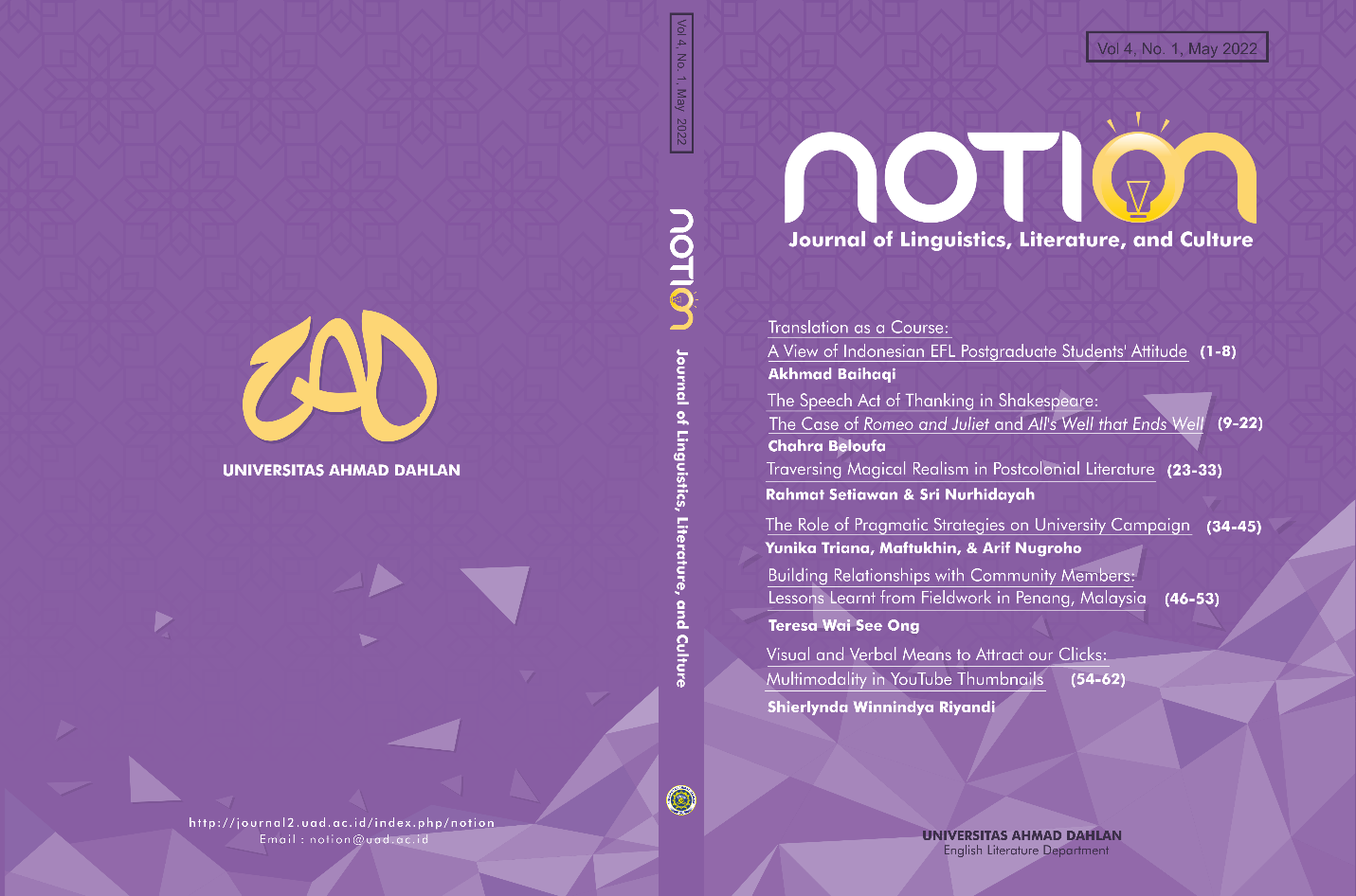Translation as a Course: A View of Indonesian EFL Postgraduate Students’ Attitude
DOI:
https://doi.org/10.12928/notion.v4i1.5743Keywords:
Indonesian EFL , students’ attitude , translation courseAbstract
The objective of this research is to investigate the Indonesian EFL Postgraduate students’ attitudes towards the course of translation. The researcher used a case study method by managing observation, interview, and questionnaire to collect the data. The questionnaire contained 30 items concerning students’ attitudes in terms of behavioral, cognitive, and emotional aspects. The participants in this present study were 11 students of the English Education Department of Postgraduate degree at a public university in Banten Province, Indonesia. The results indicate that the students hold positive attitudes toward the existence and the learning process of the translation course. These can be verified from the results of questionnaires which show that the average scores of positive attitudes for behavioral, cognitive, and emotional aspects consecutively are 74.3%, 80.6%, and 84.4%. These positive attitudes are not only affected by the lecturer-student interaction, but also by the cooperative learning atmosphere and experience that the lecturer and students manage while having a teaching and learning process of translation. Since attitudes can be modified by the experience, the effective translation teaching and learning process can encourage students to be more positive towards the translation course they are involved in.
References
Ahmad, S. (2015). Improving students’ skills in translation through students-teams achievement division (STAD) technique. Al-Ta lim Journal, 22(2), 119-128. http://journal.tarbiyahiainib.ac.id/index.php/attalim/article/view/121
Bassnett, S. (2013). Translation studies. Routledge: New York.
Gustini, A., & Baihaqi, A. (2021). Enhancing students’ translation works: A case for translation teaching. Cakrawala Pedagogik, 5(1), 53-62. https://stkip.syekhmanshur.ac.id/jurnal/index.php/CP/article/view/217
Hatim, B. A. (2014). Teaching and researching translation. Routledge: London.
Hoed, B. H. (2006). Penerjemahan dan kebudayaan. Jakarta: Pustaka Jaya.
Hollander, H. W. (1995). Penerjemahan: suatu pengantar. Erasmus Taalcentrum: Jakarta.
Jihad, A., & Haris, A. (2008). Esensi belajar dan pembelajaran. Yogyakarta: Lukita.
Khotimah, K., Wahyudin, W., & Rohbiah, T. S. (2021). Students’ perception of Google Translate in online English learning. Journal of English Language Teaching and Cultural Studies, 4(2), 78-85. https://jurnal.untirta.ac.id/index.php/JELTS/article/view/12016
Khairunnisa, K., & Lukmana, I. (2020). Teachers’ attitudes towards translanguaging in Indonesian EFL classrooms. Jurnal Penelitian Pendidikan, 20(2), 254-266. https://ejournal.upi.edu/index.php/JER/article/view/27046
Leung, C., & Valdés, G. (2019). Translanguaging and the transdisciplinary framework for language teaching and learning in a multilingual world. The Modern Language Journal, 103(2), 348-370. https://kclpure.kcl.ac.uk/portal/en/journals/the-modern-language-journal(868272a4-3448-425a-9032-abad0fa5dca1).html
Murtisari, E. T., Widiningrum, R., Branata, J., & Susanto, R. D. (2019). Google Translate in language learning: Indonesian EFL students' attitudes. Journal of Asia TEFL, 16(3), 978. https://www.proquest.com/openview/d418f85fcb0d7ec1b350112a11c5bedb/1?pq-origsite=gscholar&cbl=4424407
Newmark, P. (1991). About translation (Vol. 74). Clevedon: Multilingual Matters.
Pickens, J. (2005). Attitudes and perceptions. Organizational behavior in health care, Jones and Bartlett Publishers, Sudbury, 4(7), 43-76. https://www.academia.edu/5923221/Organizational_Behavior_in_Health_Care
Pym, A. (1992). Translation error analysis and the interface with language teaching. The teaching of translation, 279-288. https://minerva-access.unimelb.edu.au/handle/11343/295983
Schwarz, N., & Bohner, G. (2001). The construction of attitudes. Blackwell handbook of social psychology: Intraindividual processes, 1, 436-457.
Setyaningsih, R. W. (2020). Food name translation practice: A case study of Indonesian–English menus. NOTION: Journal of Linguistics, Literature, and Culture, 2(2), 70-79. http://www.journal2.uad.ac.id/index.php/notion/article/view/2936
Siregar, R. (2018). Exploring the undergraduate students perception on translation: A preliminary step to teach translation in EFL classes. English Language Teaching, 11(9), 90-101. https://eric.ed.gov/?id=EJ1188570
Sudrajat, W. N. A., & Purnawarman, P. (2019). Students’ perceptions on the use of google docs as an online collaborative tool in translation class. Lingua Cultura, 13(3), 209-216. https://journal.binus.ac.id/index.php/Lingua/article/view/5969
Sujarwo, S. (2020). Students’ perceptions of using machine translation tools in the EFL classroom. Al-Lisan: Jurnal Bahasa (e-Journal), 5(2), 230-241. https://www.journal.iaingorontalo.ac.id/index.php/al/article/view/1333
Syamardali, M. F. S., & Ismael, A. M. H. (2017). Translation as a tool for teaching English as a second language. Journal of Literature, Languages and Linguistics, 40, 64-69. https://core.ac.uk/download/pdf/234693492.pdf
Downloads
Published
Issue
Section
License
Copyright (c) 2022 Akhmad Baihaqi

This work is licensed under a Creative Commons Attribution 4.0 International License.
Authors who publish their articles in NOTION: journal of Linguistics, Literature, and Culture agree to the following terms:
- Authors retain the copyright and grant the journal right of first publication with the work simultaneously licensed under a Creative Commons Attribution 4.0 International License that allows others to share the work with an acknowledgement of the work's authorship and initial publication in this journal.
- Authors are able to enter into separate, additional contractual arrangements for the non-exclusive distribution of the journal's published version of the work (e.g., post it to an institutional repository or publish it in a book), with an acknowledgement of its initial publication in this journal.
- Authors are permitted and encouraged to post their work online (e.g., in institutional repositories or on their website) prior to and during the submission process, as it can lead to productive exchanges, as well as earlier and greater citation of published work.





